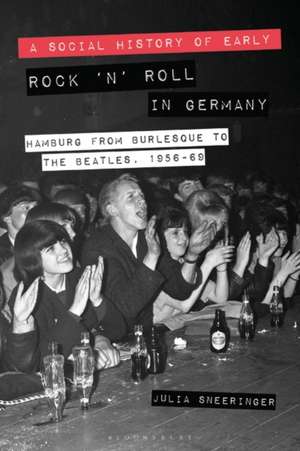A Social History of Early Rock ‘n’ Roll in Germany: Hamburg from Burlesque to The Beatles, 1956-69
Autor Associate Professor Julia Sneeringeren Limba Engleză Paperback – 27 noi 2019
| Toate formatele și edițiile | Preț | Express |
|---|---|---|
| Paperback (1) | 232.43 lei 6-8 săpt. | |
| Bloomsbury Publishing – 27 noi 2019 | 232.43 lei 6-8 săpt. | |
| Hardback (1) | 716.73 lei 6-8 săpt. | |
| Bloomsbury Publishing – 30 mai 2018 | 716.73 lei 6-8 săpt. |
Preț: 232.43 lei
Preț vechi: 297.94 lei
-22% Nou
Puncte Express: 349
Preț estimativ în valută:
44.48€ • 48.30$ • 37.36£
44.48€ • 48.30$ • 37.36£
Carte tipărită la comandă
Livrare economică 23 aprilie-07 mai
Preluare comenzi: 021 569.72.76
Specificații
ISBN-13: 9781350139534
ISBN-10: 135013953X
Pagini: 304
Ilustrații: 16 bw illus
Dimensiuni: 156 x 234 x 21 mm
Greutate: 0.43 kg
Editura: Bloomsbury Publishing
Colecția Bloomsbury Academic
Locul publicării:London, United Kingdom
ISBN-10: 135013953X
Pagini: 304
Ilustrații: 16 bw illus
Dimensiuni: 156 x 234 x 21 mm
Greutate: 0.43 kg
Editura: Bloomsbury Publishing
Colecția Bloomsbury Academic
Locul publicării:London, United Kingdom
Caracteristici
Contextualizes rock'n'roll within a longer history of entertainment and popular culture, and connects it to other musical styles
Notă biografică
Julia Sneeringer is Associate Professor of History at Queens College and the Graduate Center, City University of New York, USA. She is the author of Winning Women's Votes: Propaganda and Politics in Weimar Germany (2002).
Cuprins
List of IllustrationsIntroduction1. A Brief History of Entertainment in St. Pauli2. The Birth of the Rock'n'Roll Clubs3. The Musicians4. Fans and Audiences5. The Authorities6. The End of the Hamburg SceneEpilogueSelect BibliographyIndex
Recenzii
The book is at its best when presenting the local scene in its richness, describing players and contestants and their environs, motivations, and aspirations.
This book brings together several different types of first-hand materials to highlight the significance of St. Pauli as a space for musicians, audiences, and many more to converge and question what life could be in post-war Germany. Sneeringer makes music the central focus of the book and uses that focus to explore the people, the place, and the district of St. Pauli, which continue to have a significant role in Hamburg today.
Sneeringer adds to the ever-expanding scholarship around popular culture, rock 'n' roll, youth, and urban spaces. Her case study, as well as her efforts to explore discussions tied to music, delinquency, gender, and sexuality offers those intrigued by the work of scholars like Leif Jerram an important look into daily life throughout this period. The author's use of sources beyond government documents and traditional newspapers diversifies the story line and adds alternative perspectives.
We've known for a very long time that Hamburg -- and St. Pauli in particular -- was a crucible of rock 'n' roll vitality during the 1960s, both as an engine of West German youth culture and as a conduit for transnational influences from Liverpool, the United States, and elsewhere. But only now, with Julia Sneeringer's brilliantly executed social history, do we have full chapter and verse.
This riveting social history is also a sonic biography of Hamburg's St. Pauli district, nerve center of early rock & roll in West Germany. Sneeringer's lively prose brings the rollicking scene to life: its labor, fandom, commerce, community, sex, and especially its music. Made me feel like I was there (and made me wish I had been).
Sneeringer has produced an intellectually engaging and very readable book that examines the everyday realities, experiences, dreams, and mythologies of a city that held its own particular histories, mysteries, secrets, and soundscapes in the personal narratives of post-war popular music.
This book brings together several different types of first-hand materials to highlight the significance of St. Pauli as a space for musicians, audiences, and many more to converge and question what life could be in post-war Germany. Sneeringer makes music the central focus of the book and uses that focus to explore the people, the place, and the district of St. Pauli, which continue to have a significant role in Hamburg today.
Sneeringer adds to the ever-expanding scholarship around popular culture, rock 'n' roll, youth, and urban spaces. Her case study, as well as her efforts to explore discussions tied to music, delinquency, gender, and sexuality offers those intrigued by the work of scholars like Leif Jerram an important look into daily life throughout this period. The author's use of sources beyond government documents and traditional newspapers diversifies the story line and adds alternative perspectives.
We've known for a very long time that Hamburg -- and St. Pauli in particular -- was a crucible of rock 'n' roll vitality during the 1960s, both as an engine of West German youth culture and as a conduit for transnational influences from Liverpool, the United States, and elsewhere. But only now, with Julia Sneeringer's brilliantly executed social history, do we have full chapter and verse.
This riveting social history is also a sonic biography of Hamburg's St. Pauli district, nerve center of early rock & roll in West Germany. Sneeringer's lively prose brings the rollicking scene to life: its labor, fandom, commerce, community, sex, and especially its music. Made me feel like I was there (and made me wish I had been).
Sneeringer has produced an intellectually engaging and very readable book that examines the everyday realities, experiences, dreams, and mythologies of a city that held its own particular histories, mysteries, secrets, and soundscapes in the personal narratives of post-war popular music.
